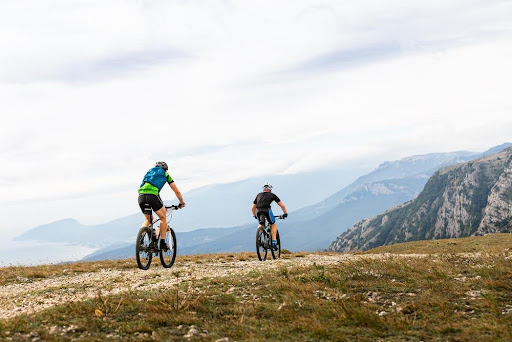Mountain biking is more than just an activity — it’s a community where diverse groups, young and old, come together to enjoy the benefits of climbing. A recent Sports and Fitness Industry Association (SFIA) report reveals a high participation rate among casual riders, with novices and less-experienced gearheads hitting the trail. This influx of fresh faces can sometimes lead to confusion, especially on single tracks where passing isn’t always easy. Understanding and practicing mountain biking etiquette is crucial to ensure a safer and more enjoyable ride for everyone.
Whether you’re new to the sport or a seasoned veteran gearing up for a busy season, use these mountain bike etiquette tips to join this vibrant community of riders.
- Watch the Road
When you’re out on the trail, safety should always be your number one concern. Accidents not only put your health at risk but also disrupt the flow of cyclists. One of the most common mistakes that can throw you off balance is losing focus on the road. Even the slightest changes in elevation can easily steer you off course if you’re not fully engaged.
That’s why it’s crucial to stay focused. Use mountain bike helmet communication to connect with your group or partner without looking away from the path or taking your hands off the bars. This way, you can navigate as a unit and give each other a heads-up when obstacles appear, ensuring a safer and more enjoyable ride for everyone.
- Let Others Pass
You likely won’t be the fastest rider on the trail. There will almost always be someone more experienced than you on the trail. Shred Trail reports that 21 percent of female riders and 40.4 percent of male riders categorize their MTB skill level as Advanced or Pro. E-mountain bikes have also risen in popularity, blazing the trail in nearly half the usual time.
Keep to the right without veering from the path to let faster riders pass on the left. Listen for other riders announcing themselves on the approach. If there’s not enough room for both bikes, pull over to let them through.
Work smarter, not harder, when climbing steep terrain. Use proper mountain bike geometry to find the correct riding position based on the incline.
- Be Cautious When Navigating Downhill
When it’s time to go downhill, yield to those going uphill to help keep momentum. It’s easier for you to brake and continue downhill than for them to pull over and start climbing from rest.
- Yield to Pedestrians and Animals
Give the right of way to hikers, mountain climbers and equestrians (those riding horses). If you get too close, you can easily injure a person or aggravate the horse. Ideally, the path will have a pedestrian or horse-crossing sign where the trails intersect. That’s your cue to slow down even if you don’t see anyone coming. Extend the same courtesy to any wildlife you encounter along the path.
- Know Your Experience Level
Most trails are marked based on difficulty, with steeper trails and sharper turns getting higher marks. You should only attempt trails rated at the advanced level if you feel confident tackling the terrain in question. If this is your first time navigating a particular trail, find a practice area to adjust your riding style accordingly. Attempting climbs before you’re ready will only slow other riders down. Bikes are fast and quiet and can easily catch creatures of all sizes by surprise.
- Respect the Environment
“Leave no trace” is the golden rule. You shouldn’t leave any trace of your time in the wilderness outside of tread marks in the mud. Carry any trash you make with you until you find a receptacle. Follow the trail markers and stick to the existing path to minimize your impact on the local ecosystem. Many trails rub up against nature preserves and pristine acres that are better off left untouched.
- Expect the Unexpected
The wilderness is anything but predictable. And increasing ridership and e-bikes will only make things more complicated. As traffic increases, slow down around sharp turns, intersections and popular lookout points to give yourself more time to brake. Control your speed when going downhill — even if there’s no one going in the opposite direction.
Plan for the worst by carrying a compass, radio, first aid supplies and a paper map of the area in case you get lost. If you can’t find your way back, the authorities might have to close the park and send in the search-and-rescue team. Use common sense and avoid taking any unnecessary risks to get home safely.
You’ll see some fresh faces on the trail this mountain biking season. Slow down and yield to anything or anyone stuck on the path. Be ready to offer assistance if someone loses their way. There’s plenty of room and mountain biking trails for all of us to enjoy this thrilling sport. Treat your fellow riders with respect to make everyone feel welcome. You might even make some new friends along the way.
Stay in touch to get more updates & news on Web of Bike Excercise!


Your comment is awaiting moderation.
Я думаю, что Вы не правы. Я уверен. Могу это доказать. Пишите мне в PM, пообщаемся.
cevrimici ‘da cok say?da promosyon promosyon sunmak-https://www.runnersworkshop.com/training/aadevin/ ve kazan slot makineleri ‘da harika oduller. Bakal?m bu slotu yenebilecek misiniz | basarabilecek misiniz?